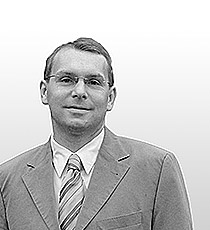

Prof. Dr. Hans-Peter Bruch
Scientific and professional career path:
- 1974 Accreditation as Doctor of Medicine
- 1975 Beginning of specialist surgical training at the University Hospital of Würzburg
- 1980 von-Langenbeck Prize of the German Society of Surgery (DGCH) together with Prof. E. Schmidt
- 1981 Specialist recognition as Surgeon
- 1982 Appointment as External Lecturer
- 1982 Senior Doctor at the University Hospital of Würzburg in the context of hand, accident, vascular and general surgery
- 1985 Head of the Surgical University Policlinic Würzburg
- 1985 Recognition as “Durchgangsarzt-Vertreter” in accordance with Section 23 (2) of the German Medical Convention (“Ärzteabkommen”)
- 1986 Sub-specialisation, Vascular Surgery
- 1986 Sub-specialisation, Accident & Emergency Surgery
- 1986 Head Senior Doctor at the University Hospital of Würzburg
- 1986 Appointment as Professor for Surgery as civil servant for life
- 1988 Consulting physician of the German Army with the “Territorialkommando Süd”
- 1990 – 2012 Director of the Clinic for Surgery of the University of Lübeck
Memberships and chairs in scientific associations:
- 1996 – 2004 Chair of the Surgical Working Community for Coloproctology of the German Society for Surgery
- 1996 European Officer of the University Colon and Rectal Surgeons
- 1997 Co-chair of the Working Community for Molecular Diagnostics and Therapy of the German Society for Surgery
- 1997 Sub-specialisation, Visceral Surgery
- 2002 – 2004 Spokesman of the “Ordinarienkonvent Viszeralchirurgie”
- 2004 – 2007 Secretary of the German Society for General and Visceral Surgery
- 2008 – 2009 President of the German Society for General and Visceral Surgery
- 2010 President of the “Berufsverband der Deutschen Chirurgen e.V.” (BDC)
- 2011 Chairman of the Joint Further Education Commission of BDC/DGCH and all surgical-scientific societies and the BVOU
- 2013 President of the “Gemeinschaft Fachärztlicher Berufsverbände e.V.” (GFB)
Other memberships:
- Member of numerous surgical societies in Germany and abroad
- Member of the Editorial Boards of various German and English-language journals
- Member of the “Leopoldina” since 1999
Interview with Prof. Hans-Peter Bruch
How do you estimate the significance of hospitals in the health system in general in the future? Medicine will undoubtedly become an out-patient regime. Ever more conditions that have so far required a stay in hospital will in the future be treated on an out-patient basis. Nonetheless, one cannot expect the number of in-patient cases to drop dramatically. According to the Eurostat surveys, 58 million more people over 65 will be living in Europe in 2050 than today. The number of those aged between 16 and 64, on the other hand, will decline by 48 million. Fifty percent of the population growth will be due to longevity. This development has already begun. People will be healthy for longer, but then the polymorbidity in age will rise substantially. If one wants to avoid dramatic rationing measures and follow the principles of the German Ethics Council and David Osoba, medicine must be aligned such that patients are treated based on the latest state of the science with the lowest costs for society and the patients themselves in order to ensure the best treatment success. This, though, means that the decision-makers will have to agree in the so-called “hospital market” to start a centralisation process. This must go hand-in-hand with increasing specialisation and network forming between hospitals on different care levels and practices.
What will be the greatest challenge in the future for clinics and hospitals? The greatest challenge lies in the necessity to find an optimum adjustment to the demographic trends and the limited financial resources and nonetheless be able to offer high-quality medicine. In the periphery this will probably succeed only if smaller clinics are operated in the consultant system and cross-sector care, cross-sector training of junior colleagues and cross-sector fees are really realised at last. Any group of hospitals with different care levels, a large number of practices, practice communities and medical care centres could thus be contractually secured and grouped around one maximum provider. One would have to establish which care levels assume which tasks and how one replaces high-performers if they should unexpectedly drop out. All in all, a new form of collegial collaboration has to be found for the benefit of the patient.
Will a hospital in the future tend to serve a local or a supra-regional market? There is no clear answer to that question. If one were to follow the lines of the German Government and uphold – even if thinner – care across the board, small, local establishments will ensure basic and regular care, whereby those terms are new and need to be clearly defined. Apart from that, there will be increasing centralisation towards focal point and maximum care, whereby these establishments, depending on the specialisation of their departments, will under certain circumstances have a broad supra-regional catchment area.



Matthias Diemer, MBA
Professional career path:
- Until October 2002, Senior Doctor in accident and restorative surgery, Klinikum Bremen-Nord.
- 2002–2008 Head of the operating room service centre, operating room coordination and management, Klinikum Bremen-Nord
- 2008–2011 Operating room Manager, Campus Kiel, University Hospital of Schleswig-Holstein
- From 2011, Operating room Manager AMEOS Group and Consultant in the network of the UCM (UKE Consult und Management GmbH of the Uniklinik Eppendorf)
- Since 1 October 2014, interim head of operating room management, Charité — University Medicine, Berlin
Functions:
- 1st Chair of the Board, “Verband für OP-Management” (VOPM)
- Member of the Professional Association of German Surgeons
- Member of the Scientific Board, key operating room indicators, VOPM / digmed GmbH
- Co-publisher: “OP-Management”,1st and 2nd editions, MWV-Verlag Berlin
- Lecturer in operating room management at the Academy of the VOPM
- Member of the Scientific Board at the congress “Challenges of Operating room Management” in Bremen
Interview with Matthias Diemer
How do you estimate the significance of hospitals in the health system in general in the future? The significance of the hospitals in the healthcare system will increase if the linkage of primary, secondary and tertiary care succeeds. This requires particular attention to integration of medical care centres and hospitals. In that market position, out-patient surgery will be expanded in the existing structures of the hospitals.
What will be the greatest challenge in the future for clinics and hospitals? The structuring of the service portfolio and the process organisation geared to that under the aspect of efficiency and economic viability.
Will a hospital in the future tend to serve a local or a supra-regional market? The hospitals will have to orientate themselves around their established and feasible competencies and the spectrum on the market resulting from that. That will lead to specialisation being added to a supra-regional market while at the same time the regional care will take place within the established care mandate. A hospital should then advertise for the supra-regional market if it can provide the organisation for that.



Prof. Wilfried von Eiff
Univ.-Prof. Wilfried von Eiff is Head of the Centre for Hospital Management (University of Münster) and Professor for Health Care Management at the HHL Leipzig Graduate School of Management. In the function of Administrative Director, he was a member of the Executive Board of the University Hospital of Giessen. Moreover, he was a senior manager in the automotive industry for several years.
He graduated with a doctorate at the Economic Sciences Faculty of the University of Tübingen and at the Medical Faculty of the University of Gießen; he qualified as a university lecturer in General Business Studies at the University of Würzburg. He is Deputy Chairman of the Supervisory Board of the Kerckhoff-Klinik (Bad Nauheim) and co-founder of the “Tour der Hoffnung”, a goodwill event that has been successful for over 30 years for the benefit of children suffering from cancer and leukaemia.
One focal point of his scientific work is research into the medical, economic and health policy effects of hospital infections. He leads the sub-project “Burden of Disease” as part of the EU study into cross-border hygiene prophylactics (EurSafety).
In 2007, he presented the comparative study on the hygiene effectiveness of disposable versus reusable textiles in the operating room, which proved the advantages of reusable textiles under the aspects of hygine safety, process costs and comfort in use. Furthermore he led the REDIA Study, the only long-term study into the implications of the DRG System in the acute area on the costs and quality situation in rehabilitation. Based on those findings, he developed a 12-point programme for more efficient cooperation between hospitals and rehab clinics.
Interview with
Univ.-Prof. Wilfried von Eiff
How do you estimate the significance of hospitals in the health system in general in the future? Also in the future, hospitals will be the main element of medically qualified and across-the-board care of the population. Hospitals, however, will provide care in network groups with general practitioners and medical care centres, as well as in combination with patient hotels on a case-focused basis and coordinated across the healthcare sectors. This development goes hand-in-hand with formation of cross-sector centres of competence for complex diagnoses, catalogue diseases and forms of intervention with minimum quantities policy as a quality prerequisite and procedures that require a specific infrastructure, such as robot-based methods or hybrid operating rooms.
What will be the greatest challenge in the future for clinics and hospitals? One central challenges for the hospitals — and here in particular the maximum care providers — will be ensuring hygiene, which means avoidance of infections of all kinds. This relates especially to MRSA, VRSA, MSSA, the Norovirus and Clostridium Difficile. Particular attention will be needed for critical transmission paths, such as care home and emergency patients, as well as on critical care situations such as in intensive care units. The incidence of nosocomial infections is between five and eight percent of hospital admissions. At the core, it is all about prevention of the most common nosocomial infections: Urinary tract infections, postoperative wound infections (surgical site infections), vascular catheter-associated infections and infections of the lower respiratory tracts. The costs of these complications are substantial: A MRSA infection results in extra costs for the hospital of about 8,200 Euros, pneumonia causes an additional 29,300 Euros and a postoperative wound infection on average 11,400 Euros. As at least 50 percent of these infections are considered avoidable, it will come down to controlling the bacterial transmission channels in the operating room, for example through use of effective agents for preoperative skin disinfection and use of clinical textiles with high bacterial barrier protection.
Will a hospital in the future tend to serve a local or a supra-regional market? Hospitals with a portal character will tend to act as local players. Specialised clinics and centres of competence for complex diagnoses like in the area of oncology have a supra-regional catchment area with regard to diagnostics and surgical interventions and radiotherapy. In addition come hospitals in areas close to borders, which are integrated into the cross-border care. Apart from that, there will increasingly be hospitals that take care gaps in other countries as a reason to attract international patients. The development of telemedicine will ensure that even hospitals in rural areas can provide good medical quality. To that extent, even regional and local players can revert to special competence located elsewhere in the information group.



Roland Fehringer, denkstatt GmbH
Roland Fehringer is a plastics engineer with additional training as a plastics waste disposal engineer. From 1993 to 2007, he worked at the Technical University of Vienna, Institute for Water Quality, Resource Management and the Waste Industry. Among other things, his tasks included the planning, management and conduct of research projects in the areas of waste management, regional substance and resource management, including sampling in the field, sample preparation and chemical analysis. From 2000 onwards, he was responsible in several international, interdisciplinary research projects of the EU for the sub-segment of the Institute of the TU Vienna. His work as a reviewer of the Journal of Waste Management & Research (2002–2007) also falls in that time.
Since 2007, Roland Fehringer has been responsible as Senior Consultant for the area of “Product Sustainability” with the Vienna-based sustainability consultants, denkstatt GmbH. Further tasks are process responsibility for information management, co-responsibility for the IT and safety counsellor and first aider. Since 2007, he has led more than 150 projects to assess environmental impact (Eco-balance, Environmental Product Declarations, Product Carbon Footprint, Consumer Carbon Footprint, Project Carbon Footprint, Water Footprint, Cost-Benefit Analysis, Cost-Effectiveness Analysis etc.). Among the products evaluated are, among others, all usual packaging materials, disposable and reusable beverage packaging, flowerpots in conventional plastics and plastics from regenerative raw materials, pathways and squares, water turbines, office buildings and houses, sugar and beer. The companies and projects evaluated include banks, garden centres and the Austrian Chamber of Commerce, as well as gas and pipeline projects.
In 2012, he drew up the study “Product Carbon Footprint of Surgical Gowns”. The goal of the analysis was to calculate the greenhouse gas potential of reusable and disposable gowns for the operating room area with 1,000 applications. The analysis covers the entire life-cycle and looks at the most common materials for disposable and reusable gowns. In 2013, the analysis was extended on the one hand to all textile operating room supplies (tablecloths, drapes etc.) and, on the other hand, by further environmental effects, such as the environmental burden of transport on air quality and contamination of water bodies through detergents. He was able to present the results of the ecological assessment in Austria to the Ministry for the Environment and at the Expert Round Table on the topic of “Sustainability in the Austrian Healthcare System &mdash the Sustainable Hospital” in May 2013 and in Germany at the 5th Procurement Congress of the Hospitals in December 2013 in Berlin and at the 11th Operating Room Management Congress in April 2014 in Bremen.
Interview with Roland Fehringer
How do you estimate the significance of hospitals in the health system in general in the future? I can really imagine that the path being discussed in Austria can bring, above all, economic and social advantages for all stakeholders (doctors, patients and insurers). The first point of contact should be a local doctor’s practice, where general practitioners and specialists in very different disciplines work together. That relieves the hospitals of more simple medical problems and they can devote themselves more to complex health challenges, but also research. I do not believe that this structure can counteract the ever more progressing two-class medicine.
What will be the greatest challenge in the future for clinics and hospitals? Medical care at the highest possible level under the economic conditions given, so a trendsetting change in the healthcare system as a whole even in the near future (multiple health insurance funds etc.).
Will a hospital in the future tend to serve a local or a supra-regional market? In basic care, the hospital will almost certainly serve a local market in the future too, but the cooperation between the individual hospitals will indeed be expanded, so that specialisations of individual hospitals will lead to more cost-effective care for patients.



Heinz Kölking
After his training as a state-registered nurse at the University Hospital of Münster, and the Open University of Hagen, Heinz Kölking studied economics and graduated with a degree in 1984. Until 1988, he worked in organisational consulting for hospitals at Mediplan-Krankenhausplanungsgesellschaft (architecture, medical systems and organisation). Afterwards, he was hospital director until 1994 at the Zweckverbandskrankenhaus Itzehoe in Schleswig-Holstein. From 1 July 1994 until 2013, Heinz Kölking was managing director at the Diakonissen-Mutterhaus in Rotenburg with the Diakoniekrankenhaus and various affiliated undertakings in nursing and in service. Furthermore, he was managing director at proDIAKO-Holding with seven hospitals in Lower Saxony.
After the integration of the proDIAKO facilities into AGAPLESION gAG Frankfurt, he was responsible there for corporate development. From 1999 until 2011, Heinz Kölking was president of the German Association of Hospital Directors. He has been a member in the presidium for many years and from 2011 until 2014 was president of the European Association of Hospital Directors based in Brussels. Since 1 July 2014, he has been managing director of Residenz Kliniken GmbH and Residenz-Reha-Kliniken GmbH in Bremen.
Interview with Heinz Kölking
How do you estimate the significance of hospitals in the health system in general in the future? The significance of the hospitals will increase, but they will change in terms of content and organisation. In terms of content with regard to increasing specialisation, organisationally to more integration and opening up to the partially inpatient and outpatient market, whereby the quality aspects are at the forefront. The shaping of the structural attributes and the product will certainly have to be defined and differentiated regionally.
What will be the greatest challenge in the future for clinics and hospitals? There are a few, but I believe it will come down especially to being attractive for highly qualified and committed employees. The main factors for that are: Structural quality, working atmosphere, management competence, leadership quality and cooperation.
Will a hospital in the future tend to serve a local or a supra-regional market? With increasing specialisation, supra-regional markets will gain in significance. As a result we will have supra-regional centres and regionally networked care structures. But that has its limits because of the demographic trends, especially when it’s about questions of basic care.



Oliver Leisse
Oliver Leisse, 53, was for many years a strategy consultant with international advertising agencies like DDB, TBWA, BBDO and Springer & Jacoby. In 1997, he helped to found an institute for online market research and trend research with EARSandEYES GmbH. In 2008, he called SEE MORE into life, the institute for trend research and innovative strategies in Hamburg.
The institute researches consumer insights based on qualitative ethnographic research in about 50 major cities of the world. Here the institute can call on 100 employees, who observe consumer needs locally, detect and research trends. With his team he develops new products, brands and future strategies and advises clients like Deutsche Bank, TUI, Henkel und Schwarzkopf, Microsoft, Deutsche Post, Google, Freenet, REWE and many more.
In June 2012, his book “Be prepared: 30 Trends für das Business von morgen” appeared in the Haufe-Verlag. The second edition appeared at the end of 2014.
Interview with Oliver Leisse
How do you estimate the significance of hospitals in the health system in general in the future? As the area of health is one of the central topics and trends of the future, the hospital will reinvent itself from the bottom up – more as the positively regarded place of health optimisation than the place at which one can “be rid of” one’s illnesses.
What will be the greatest challenge in the future for clinics and hospitals? To recognise this transformation. And then to shape it.
Will a hospital in the future tend to serve a local or a supra-regional market? Like in many sectors, the premium hospital, which can offer clear added value (in whatever service dimension) will have supra-regional significance. The hospital with the standard product will serve the regional environment.



Sabine Zander
Sabine Zander was born in Berlin. After her training as a nurse, she took a course as an operating room nurse, later as a nurse for management functions in care facilities in the health and social work areas. Then followed a course as operating room coordinator and coordinator of functional areas and graduation as a healthcare and social economist (VWA). Sabine Zander is Head Nurse in operating room management at the Charité Hospital in Berlin.
Interview with Sabine Zander
How do you estimate the significance of hospitals in the health system in general in the future? The supply and demand for service in the future will be subject to higher competitive pressure through patient sovereignty and demand flexibility. The hospitals will move still more in the field of tension between medicine and service provider.
What will be the greatest challenge in the future for clinics and hospitals? Personnel bottlenecks and the costs pressure are the two great challenges for hospitals in Germany.
Will a hospital in the future tend to serve a local or a supra-regional market? The hospital of the future will tend to serve a supra-regional market. Besides the care mandate, the strategic direction of the hospitals will offer a clear specialisation profile for certain supra-regional patient groups and therapy areas.

